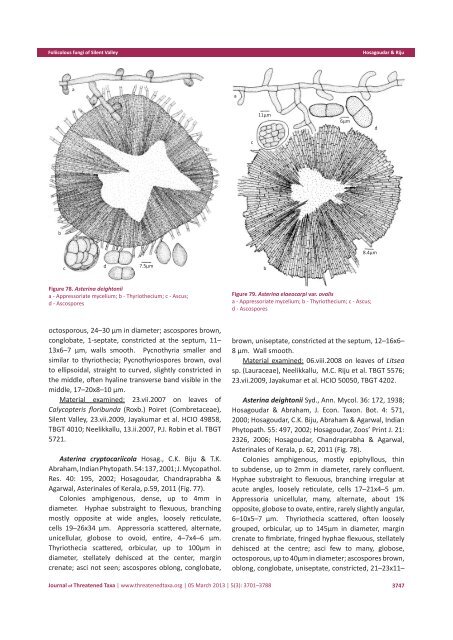PDF - Journal of Threatened Taxa
PDF - Journal of Threatened Taxa
PDF - Journal of Threatened Taxa
You also want an ePaper? Increase the reach of your titles
YUMPU automatically turns print PDFs into web optimized ePapers that Google loves.
Foliicolous fungi <strong>of</strong> Silent ValleyHosagoudar & Rijuaa11µm6µmdcb8.4µmcd7.5µmbFigure 78. Asterina deightoniia - Appressoriate mycelium; b - Thyriothecium; c - Ascus;d - AscosporesFigure 79. Asterina elaeocarpi var. ovalisa - Appressoriate mycelium; b - Thyriothecium; c - Ascus;d - Ascosporesoctosporous, 24–30 µm in diameter; ascospores brown,conglobate, 1-septate, constricted at the septum, 11–13x6–7 µm, walls smooth. Pycnothyria smaller andsimilar to thyriothecia; Pycnothyriospores brown, ovalto ellipsoidal, straight to curved, slightly constricted inthe middle, <strong>of</strong>ten hyaline transverse band visible in themiddle, 17–20x8–10 µm.Material examined: 23.vii.2007 on leaves <strong>of</strong>Calycopteris floribunda (Roxb.) Poiret (Combretaceae),Silent Valley, 23.vii.2009, Jayakumar et al. HCIO 49858,TBGT 4010; Neelikkallu, 13.ii.2007, P.J. Robin et al. TBGT5721.Asterina cryptocariicola Hosag., C.K. Biju & T.K.Abraham, Indian Phytopath. 54: 137, 2001; J. Mycopathol.Res. 40: 195, 2002; Hosagoudar, Chandraprabha &Agarwal, Asterinales <strong>of</strong> Kerala, p.59, 2011 (Fig. 77).Colonies amphigenous, dense, up to 4mm indiameter. Hyphae substraight to flexuous, branchingmostly opposite at wide angles, loosely reticulate,cells 19–26x34 μm. Appressoria scattered, alternate,unicellular, globose to ovoid, entire, 4–7x4–6 μm.Thyriothecia scattered, orbicular, up to 100μm indiameter, stellately dehisced at the center, margincrenate; asci not seen; ascospores oblong, conglobate,brown, uniseptate, constricted at the septum, 12–16x6–8 μm. Wall smooth.Material examined: 06.viii.2008 on leaves <strong>of</strong> Litseasp. (Lauraceae), Neelikkallu, M.C. Riju et al. TBGT 5576;23.vii.2009, Jayakumar et al. HCIO 50050, TBGT 4202.Asterina deightonii Syd., Ann. Mycol. 36: 172, 1938;Hosagoudar & Abraham, J. Econ. Taxon. Bot. 4: 571,2000; Hosagoudar, C.K. Biju, Abraham & Agarwal, IndianPhytopath. 55: 497, 2002; Hosagoudar, Zoos’ Print J. 21:2326, 2006; Hosagoudar, Chandraprabha & Agarwal,Asterinales <strong>of</strong> Kerala, p. 62, 2011 (Fig. 78).Colonies amphigenous, mostly epiphyllous, thinto subdense, up to 2mm in diameter, rarely confluent.Hyphae substraight to flexuous, branching irregular atacute angles, loosely reticulate, cells 17–21x4–5 µm.Appressoria unicellular, many, alternate, about 1%opposite, globose to ovate, entire, rarely slightly angular,6–10x5–7 µm. Thyriothecia scattered, <strong>of</strong>ten looselygrouped, orbicular, up to 145µm in diameter, margincrenate to fimbriate, fringed hyphae flexuous, stellatelydehisced at the centre; asci few to many, globose,octosporous, up to 40µm in diameter; ascospores brown,oblong, conglobate, uniseptate, constricted, 21–23x11–<strong>Journal</strong> <strong>of</strong> <strong>Threatened</strong> <strong>Taxa</strong> | www.threatenedtaxa.org | 05 March 2013 | 5(3): 3701–37883747

















